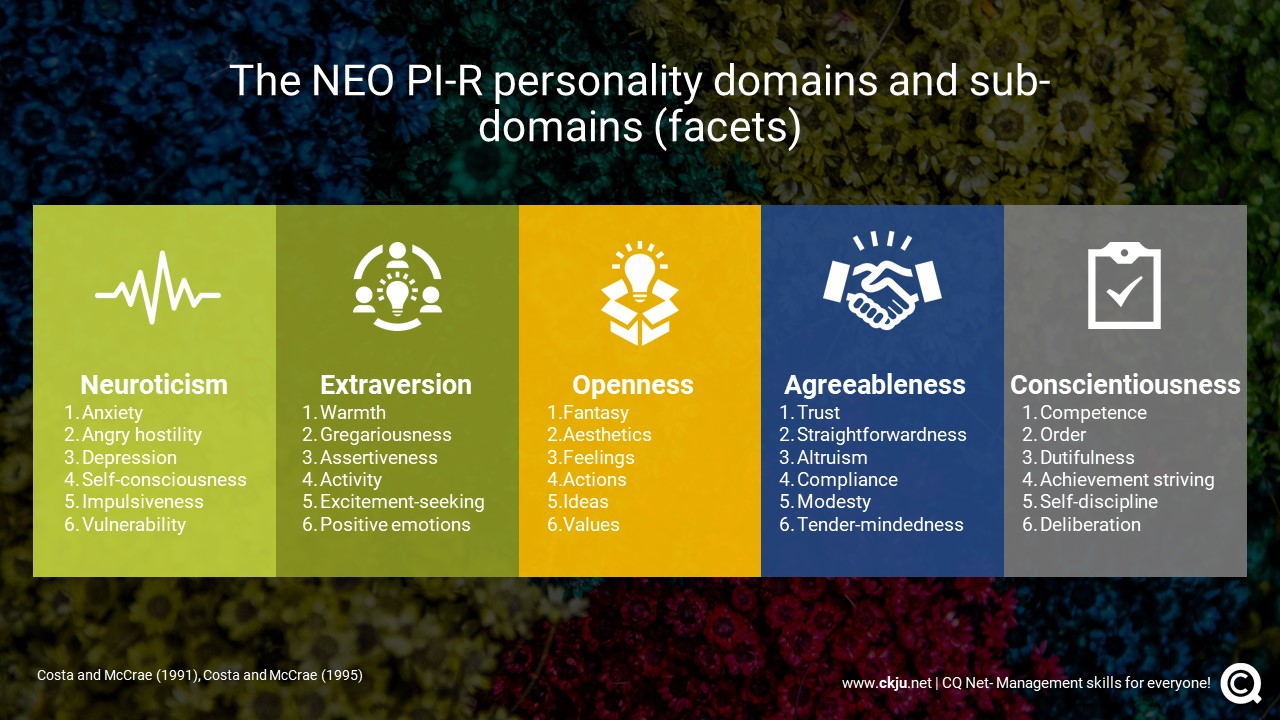- Blog
- Five Factor Model
Contents
- Since the 1990s, the Five Factor Model has been advocated as helping selection and recruitment
- The Five Factor Model of personality predicts job satisfaction
- The Five Factor Model of personality can help curb counterproductive behavior
- The Five Factor Model of personality helps determine effective leadership
- The Five Factor Model of personality can help predict career success
- How can the Five Factor Model of personality be measured?
- References and further reading
Since the 1990s, the Five Factor Model has been advocated as helping selection and recruitment
Many researchers and practitioners have advocated for the use of the Big Five Personality model for selection and recruitment (Goldstein, Pulakos, Passmore & Semedo, 2017). The five factors are emotional stability, extraversion, openness to experience, conscientiousness, and agreeableness (Costa & McCrae, 1992). In our blog post “Utilizing the Science of Personality in Evidence-Based Management: Applications, Benefits and Shortcomings” we have a detailed look at each of the five factors.
Interest in the Five Factor Model arose in the early 1990s when researchers conducted a series of meta-analytic reviews. One of the most influential of these reviews was conducted by Barrick and Mount (1991). They found a consistent relationship between conscientiousness and job performance across a wide range of job categories; however, there was little relationship between the other Big Five traits and overall job performance.
Since this meta-analysis, other researchers have attempted to pinpoint those traits that are related to job performance. Schmidt and Ryan (1993) also provide evidence that conscientiousness is related to job performance and practitioners will seek this personality trait during hiring due to its linkage to job performance (Schmidt & Ryan, 1993). Hurtz and Donovan (2000) also found that of the five factors, conscientiousness was the best predictor of job performance.
The Five Factor Model of personality predicts job satisfaction
Workers who are more satisfied in their jobs are more likely to stay in the organization, tend to be better performers and are less absent from work. Accordingly, it is important to determine if the Five Factor Model is related to job satisfaction. Research has indicated that several of the five traits are related to job satisfaction with neuroticism showing a negative correlation with job satisfaction and conscientiousness, extraversion, and agreeableness positively related to job satisfaction (Judge, Heller & Mount, 2002).
The Five Factor Model of personality can help curb counterproductive behavior
Employees deviate from acceptable workplace behavior when they engage in actions that harm the well-being of the individual or the organization. These types of behaviors include, stealing, withholding job effort (organizational deviance) and hostile behavior towards coworkers (interpersonal deviance). Interpersonal deviance is negatively correlated with high levels of agreeableness whereas organizational deviance is negatively related with high levels of conscientiousness and positively correlated with neuroticism. These findings imply that individuals who are emotionally stable and conscientious are less like to engage in organizational deviant behavior (Colbert, Mount, Harter, Witt, & Barrick, 2004).
Colbert and colleagues have also found that personality moderates the relationship between workplace perceptions and deviancy. In their study, they found that workplace deviance was endorsed with respect to an individual when job holders held a negative perception of the workplace and emotional stability, conscientiousness, or agreeableness was low (Colbert et al., 2004).
The Five Factor Model of personality helps determine effective leadership
Research has also shown linkages between the Five Factor Model and leader effectiveness. Research shows that extroverts are more likely to succeed in leadership positions. Extraversion was a valid predictor for management performance (Barrick & Mount, 1991) and Judge and Bono found that extroversion positively predicted charisma and inspirational motivation, a component of transformational leadership. Lim and Plohart (2004) also found a significant relationship between extraversion and leadership abilities.
There is also a link between agreeableness and leader effectiveness. Agreeable individuals are cheerful, adventurous, adaptable, friendly, likeable, generous, tolerant, and courteous (Barrick & Mount, 1991). Judge and Bono found agreeableness was a strong predictor of transformational leadership, accounting for 7% of the variance in transformational leadership.
The Five Factor Model of personality can help predict career success
There is also evidence that the Big Five Model is useful in predicting career success. In a study of 496 employees across a wide range of occupations and organizations, Seibert and Kramer (2001) found that extraversion was related to salary level, promotions, and career success. They also found that neuroticism was related negatively to career satisfaction (Seibert & Kramer, 2001).
In an interesting long-term study of the working lives of women, George and colleagues analyzed work over time from preliminary activities (in the twenties) to decreasing work involvement (after age 60), utilizing three of the Big Five personality traits as predictors of career outcomes (George, Helson & John, 2011). The three traits examined were extraversion (work as pursuit of rewards), openness (work as self-actualization) and conscientiousness (work as duty).
The researchers found that the socio-economic climate impacted the relationship between the personality traits and work lives. As expected, there was no significant relationship between the personality traits and work lives in the mid-60s, with young women being gender typed and family-oriented (George et al., 2011). However, as the climate changed, work outcomes were related to all three of the traits and predicted career status and satisfaction achieved, as well as continued work participation and financial security in late adulthood (George et al., 2011).
How can the Five Factor Model of personality be measured?
There are a variety of valid personality measures that can be used to assess the Big Five. The most popular is the NEO Personality Inventory that has gone through various revisions (McCrae, Costa & Martin, 2005). There is a long and short version of the NEO with the long version consisting of 240 items and the shorter version consisting of only 60 items. The measure is suitable for use with people of all ages. One of the benefits of the use of the NEO Personality Inventory is that it can assess both broad and narrow personality traits.
In closing, research on the Five Factor Model demonstrates that it is a psychometrically valid model that is related to a variety of work outcomes, including measures of job performance, satisfaction, absenteeism, leader ability, and career success. The model can be utilized by organizations as part of a larger effort to select and recruit individuals who demonstrate potential within the organization.
References and further reading
Barrick, M. R., & Mount, M. K. (1991). The big five personality dimensions and job performance: A meta-analysis. Personnel Psychology, 44, 1-26.
Colbert, A. E., Mount, M. K., Harter, J. K., Witt, L. A., & Barrick, M. R. (2004). Interactive effects of personality and perceptions of the work situation on workplace deviance. Journal of Applied Psychology, 89, 599-609.
Costa, P. T., & McCrae, R. R. (1992). Normal personality assessment in clinical practice: The NEO Personality Inventory. Psychological Assessment, 4(1), 5-13.
George, L. G., Helson, R., & John, O. P. (2011). The “CEO” of women's work lives: How Big Five Conscientiousness, Extraversion, and Openness predict 50 years of work experiences in a changing sociocultural context. Journal of Personality and Social Psychology, 101(4), 812-830.
Goldstein, H. W., Pulakos, E. D., Passmore, J., & Semedo, C. (2017). The Wiley Blackwell Handbook of the Psychology of Recruitment, Selection and Employee Retention. Wiley- Blackwell.
Hurtz, G. M., & Donovan, J. J. (2000). Personality and job performance: The Big Five revisited. Journal of Applied Psychology, 85, 869-879.
Judge, T. A., & Bono, J. E. (2000). Five-factor model of personality and transformational leadership. Journal of Applied Psychology, 85, 751-765.
Judge, T. A., Heller, D., & Mount, M. K. (2002). Five-Factor model of personality and job satisfaction: A meta-analysis. Journal of Applied Psychology, 87, 530-541.
Lim, B., & Ployhart, R. E. (2004). Transformational leadership: Relations to the five-factor model and team performance in typical and maximum contexts. Journal of Applied Psychology, 89,610-621.
McCrae R. R.; Costa P. T.; Martin T. A. (2005). The NEO PI-3: A more readable revised NEO personality inventory. Journal of Personality Assessment. 84 (3): 261–270.
Schmidt, D. W., & Ryan, A. (1993). A meta-analytic review of attitudinal and dispositional predictors of organizational citizenship behavior, Personnel Psychology, 48, 4, 775-802.
Seibert, S. E., & Kraimer, M. L. (2001) The Five-factor Model of Personality and Career Success. Journal of Vocational Behavior, 58, 1, 1-21.
Top Rated
About the Author

Comments
Most Read Articles
Blog Categories











Add comment